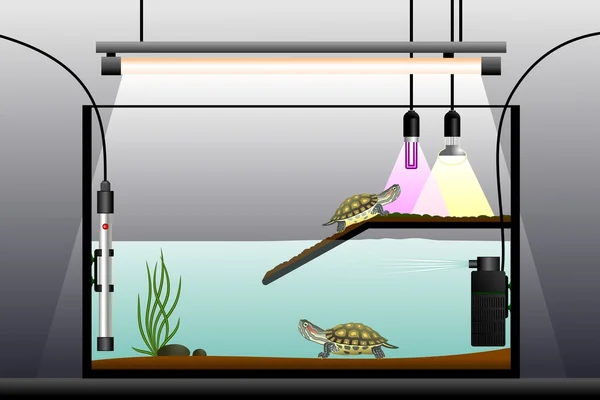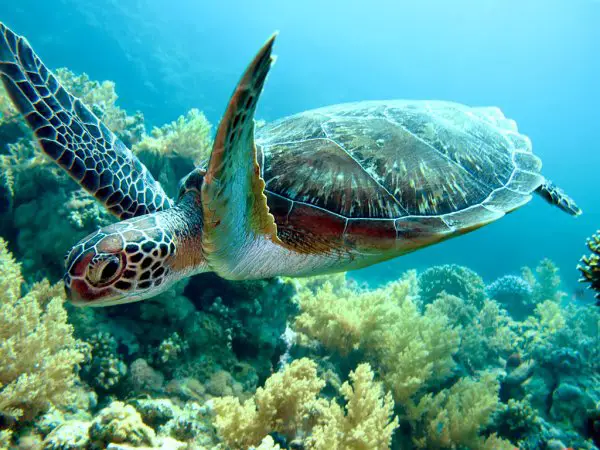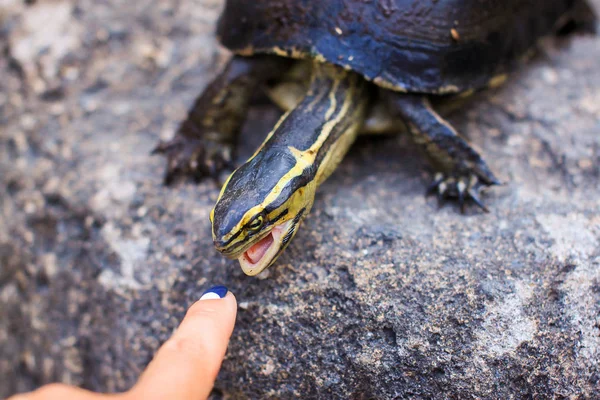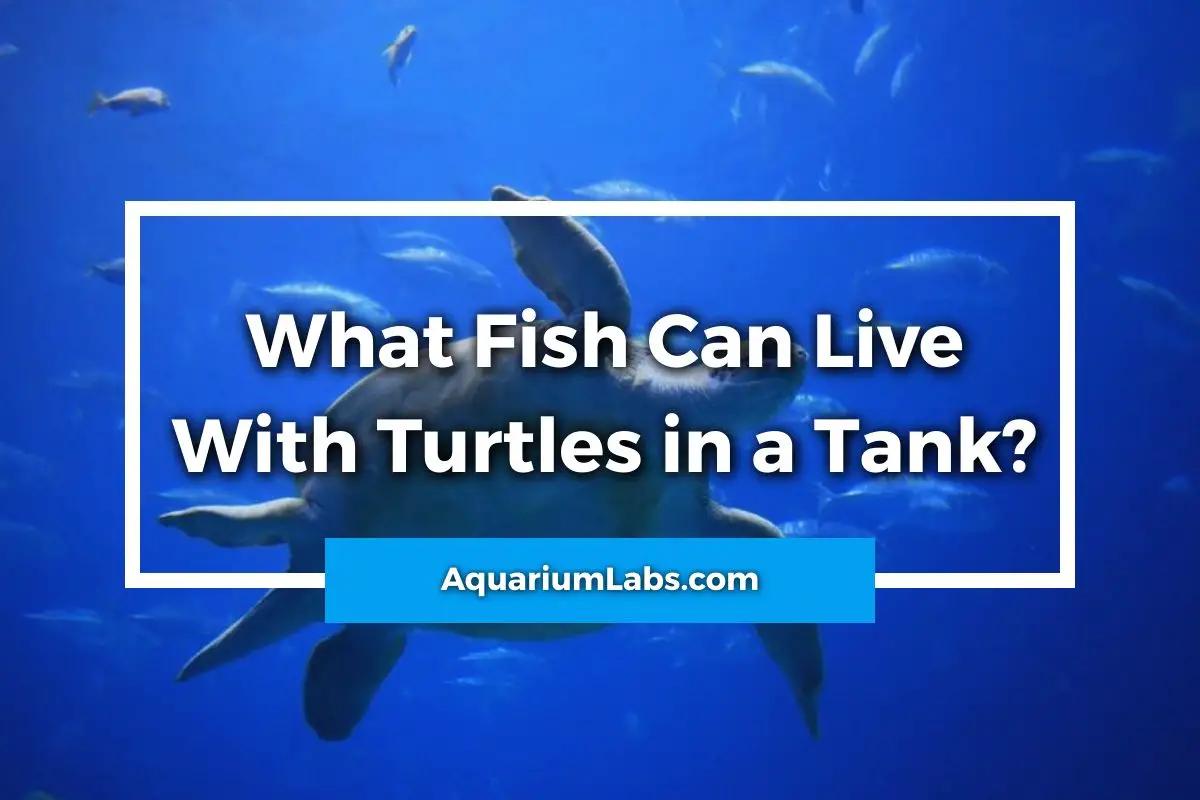Mixing animals of different groups can result in some fascinating displays!
Fish and reptiles like turtles are naturally found together in nature, right? So why not keep them together in your home aquarium or pond?
What fish can live with turtles in a tank?
Read on to find out!
What Fish Can Live With Turtles in a Tank?

Let’s dive right into this topic by stating right from the start that keeping fish in a turtle tank is not an easy task.
Most turtles eat fish any chance they get; turtles are omnivores and eat any plant or animal matter they can overpower.
Freshwater fish are a delicious and normal part of their diet. But with a little planning, it’s not impossible for turtles and fish to share the same tank!
Aquatic vs Semi-Aquatic Turtles
When setting up a habitat for your fish and turtles to live in the same aquarium, you’ll need to consider the needs of your turtle. Most turtles need both water to immerse themselves in as well as a warm, dry place to bask in the sun.

There are very few turtle species that are fully aquatic. Basically, sea turtles are the only ones that don’t need land to bask on. And even they still return to the shore to lay their eggs in the sand.
All other turtles live both on land and in water to varying degrees. Some, such as snake-necked and soft-shelled turtles, spend a lot of time in the water.
While others, such as the Red-Eared Slider, bask often. And there are land dwellers like Box Turtles, which don’t swim very much and prefer staying on land.
Turtles need a lot more space than you might expect. They are stereotyped as sluggish and slow – and they are when they are still cold from the night and haven’t basked to soak up heat from the sun.
Once your turtles are fully warmed up, they are very fast and active. Fast enough, unfortunately, that they often catch fish from their hiding places.
Turtles and Fish: Dietary Concerns
As I mentioned earlier, the main problem with keeping turtles and fish in the same tank is that turtles love eating fish.
Most turtle species that live in the water eat fish occasionally, including common pet store species like Red Eared Sliders, Painted Turtles, and Mud and Musk Turtles.
Turtles are well adapted to hunt fish as they swim quickly and are very agile underwater.
Fish also have no real escape since they share the same aquarium. Eventually, a fish will get trapped in a corner or inside their hiding places, and the turtle will win an easy meal.
One way to keep your tropical fish from ending as lunch for your turtles is to keep your turtles very well fed.
Feeder fish can be used as sacrifices; they are ideally sized to be eaten
by turtles. This is perfect if you have very small or very large fish that live inside the turtle tank.
Feeder fish include goldfish, rosy red minnows, but not feeder guppies. Guppies are too small for adult turtles to catch, but they make a good tank mate since they breed readily!

Turtles and Turtle Waste
Anyone who has kept a turtle tank knows that they are extremely messy animals. Turtles both eat and poop in their water, which can become incredibly foul if not well filtered and changed on a regular basis.
In fact, this is why turtles under 4 inches are illegal in the USA; they were extremely popular with children.
However, kids weren’t keeping their turtle’s tank clean enough, which caused a spike in cases of salmonella and other bacterial diseases to surge across the country.
Turtles and Water Quality
Many fish species are also very sensitive to the high germ load that an unclean turtle or fish tank creates. Fish can also be harmed by elevated levels of ammonia, nitrite, and nitrate, which turtles produce a lot of.
Aquatic turtles often poop directly into their water, which means feces, bacteria, leftover food, and more, all wafts into the gills of their tank mates constantly.
Even if you aren’t keeping turtles and fish in the same tank, the turtle setup should have powerful filtration. A power filter hanging on the back with a siphon is a bare minimum.
But a strong canister filter will do an even better job processing turtle waste and keeping both the turtle and fish species healthy!
Even turtles don’t enjoy water full of bacteria and ammonia to swim in and will be sickened by it if the conditions never improve.
Can Goldfish Live with Turtles?
Many tropical fish do better when keeping turtles in the same tank. But koi fish and goldfish offer some real problems when kept alongside turtles. Turtles eat fish, and goldfish are the most common species to offer them.
They are fairly slow and easy to breed and catch. So many turtles recognize goldfish and koi fish as food and will chase them down mercilessly.
Large goldfish and koi may be safe in an aquarium with turtles, but it is still very risky. Should the turtle decide to try biting its fish tank mates, the goldfish will likely get wounds that become infected, possibly killing it.
Goldfish produce a lot of waste as well. Not as much as turtles, but they are still dirtier than most tropical fish. Even a powerful filter might not be able to keep up with the leftover food and poop from both goldfish and turtles.
Keeping Goldfish, Koi, and Turtles Together in Outdoor Ponds

If you want to keep goldfish, koi, and turtles together, then you are much better off keeping them in a pond. Ponds offer several benefits for all of these animals. They provide enough space for even bite-sized goldfish to escape a hungry turtle.
Ponds ensure that your fish grow large enough to no longer be considered food. And it is easy to provide enough water to prevent all that turtle and fish poop from easily fouling it.
Good pond turtles include Western Painted Turtles, Softshell Turtles, and the Red-Eared Slider, all of which are commonly found in pet stores. Since these turtles all mature anywhere from 8 to 12 inches in shell length, they are too small to do harm to an adult goldfish or koi.
Feeding Your Pond Turtle
The key to keeping the two together in a pond habitat is accounting for size and hunger. The hungrier your turtles are, the more likely they are to try for a fish. But if they are trained on regular feedings, then they know to wait on you.
Besides a high-quality prepared turtle food formula, you should also offer meaty snacks on occasion to stave off any cravings they may have. Slices of raw seafood like white fish and shrimp will give them any missing nutrients and fat they crave that their pellets aren’t providing.
Watch Out for Snapping Turtles
That said, stay away from the many species of snapping turtle. Both the Common and Alligator Snapping Turtles are specialist fish hunters. They have razor-sharp jaws that allow them to not only catch small fish but literally bite larger fish in half.
Snapping Turtles rarely adapt to eating pellets and will eat any fish in the same tank or pond.
They also grow huge! Alligator Snapping Turtles are one of the heaviest turtles in the world, adding hundreds of pounds in bulk over their lives and measuring several feet long. They are a danger not only to your fish but also to you.
Alligator Snapping Turtles have been known to sever fingers and toes with the strength of their bite! They will even eat smaller turtles.
Can Betta Fish Live with Turtles?

Unfortunately, bettas and turtles should never be in the same tank. Turtles love eating fish, and bettas are one of the easiest meals they will ever come across. Betta fish are very slow, with long fins to weigh them down.
They are also fairly small, at only 2 to 3 inches. Even a baby turtle will gladly snap at a brightly colored betta – and an adult turtle will eventually make a snack out of it.
Bettas are also tropical fish that need warmer conditions than many turtles do. Many fish and turtles prefer warm, heated water (70-82 Fahrenheit). But sometimes aquarists decide to keep the water at room temperature because temperate species, like Red Eared Sliders, will still thrive.
Also, many turtles dive and swim recklessly, which can end up in a cracked heater. Cracked heaters are extremely dangerous because the electricity can cause the death of your turtles or other animals.
So, in short: the best tank mates are fish that are faster, larger, or very tiny compared to your turtles.
Good Tropical Fish Species to Keep with Turtles
We’ve talked a lot about goldfish and koi as possible aquarium fish to live alongside turtles. But what other options are out there?
Tetras and Guppies

Believe it or not, small fish can make excellent tank mates for turtles. The key is to provide the turtles with enough food that it’s simply not worth trying to chase down small, fast-moving fish.
Stay away from fancy guppies, which have long, flowing fins that not only slow them down but are eye-catching and tempting for turtles to chase.
Feeder guppies are both quick and inexpensive in case a turtle succeeds at grabbing a few. They also reproduce so quickly that you’ll likely end up with many more than you started with.
Tetras of all kinds are extremely quick and all but impossible for a turtle to catch in a fish tank. These aquarium fish do need both warmth and clean water.
Unfortunately, most indoor aquariums with turtles can become very high in ammonia due to their leftover food and feces, which tetras tend to be sensitive to. So keep up with the maintenance if you decide to choose them!
Feeder Fish like Rosy Red Minnows
Rosy reds are actually a popular species of feeder fish that are often sold as turtle food. They are cyprinids (carp) and therefore closely related to goldfish and koi. But they are much slimmer than their bulkier cousins.
Rosy reds are also very hardy and can tolerate the higher levels of waste found in a turtle tank. So long as the tank has plenty of swimming space to avoid a hungry turtle, they will live well alongside them.
Rosy red minnows are hardy and omnivorous, feeding on flakes and any leftover food the turtle drops in the water! By scavenging on turtle meals, these fish also help keep the tank clean by reducing the chances of ammonia forming from rotting food.
Ensuring Your Fish Survive Alongside a Turtle
Choose a Small Turtle
Young turtles are better for aquarium fish because they are too small to do much harm, especially if your fish are larger than the turtle. Just be sure you aren’t choosing fish that get large enough to eat the turtle! An Oscar or other predator would certainly love eating a small turtle.
Small turtles will likely try eating guppies and other small fish, but they aren’t very good at catching them, especially if the tank is spacious enough.
Keep the Turtle Well Fed
One of the best ways to ensure your fish can live alongside turtles is to keep the turtles well fed.
Once the turtles are trained to know that food is available on-demand as needed, they won’t bother working hard to chase fish around.
Like all ectothermic animals (those that don’t produce their own heat), turtles have a strict energy budget. And they never expend more than they need to.
Provide Plenty of Living Space for Both
Fish and turtles both enjoy having as much living space as possible. Extra space provides them with enough room to avoid one another.
In a small tank, a turtle going for a swim can’t help but notice the colorful meals wandering around. In a larger tank, the fish can steer clear, and everyone is happier.
Extra space also helps when you introduce fish to the tank for the first time. A new fish will likely be confused and dazzled by the lights and newness of its surroundings. Dashing about, it may attract the attention of a hungry turtle.
These first few minutes are often the most dangerous for your new fish since it doesn’t know where to swim to safety. A spacious tank ensures that the turtle can’t easily trap the fish and grab hold of it.
Choose Very Large or Very Small Fish
Lastly, it’s best to stick to the extremes when choosing other fish to live alongside your pet turtle.
Very small, schooling fish are so fast that the turtle will likely give up, especially if the tank is spacious. And very large fish are too big to make an easy meal. This includes large carp like goldfish and koi as well as tiny fish like feeder guppies and neon tetras!
Wrapping Things Up

Keeping a turtle alongside fish is a risky project. Turtles are messy predators and can easily kill fish indirectly through bacteria and ammonia buildup. Or directly by grabbing an unwary fish. It takes a lot of planning to make it work if you are keeping them together in an indoor aquarium.
But you will have a much easier time of it when keeping turtles and fish together in an outdoor pond. The sheer amount of space makes it too much trouble for a lazy, well-fed turtle to bother!
FAQs:
- How to Clean Fish Tanks
- Can You Over Filter a Tank?
- Why Do Fish Jump Out of Their Tanks?
- What Are Good Aquarium Gifts?

